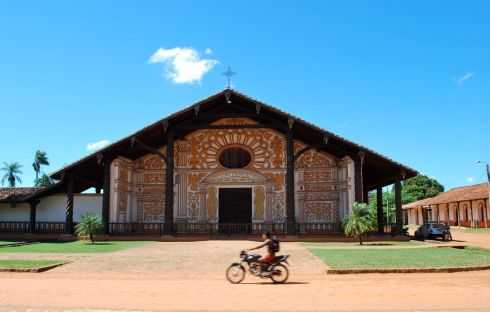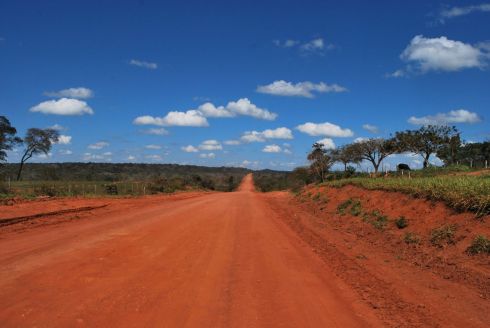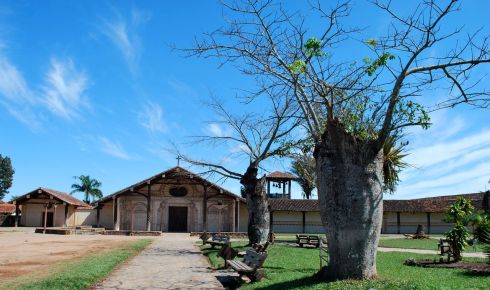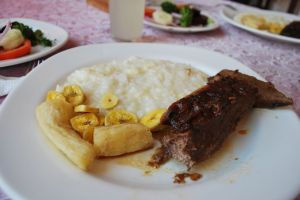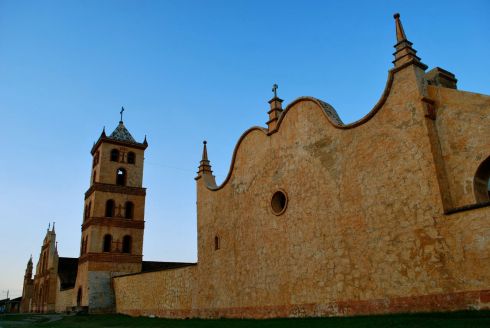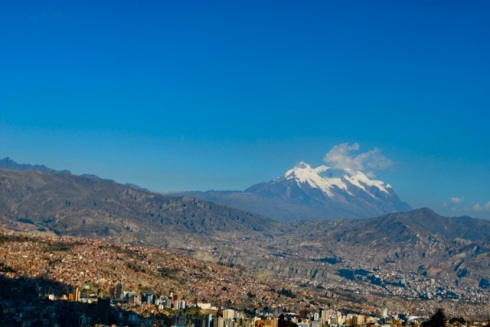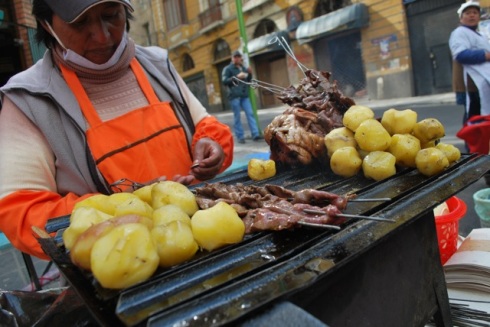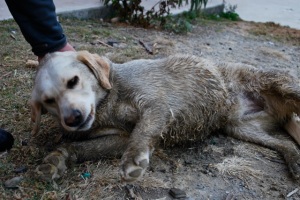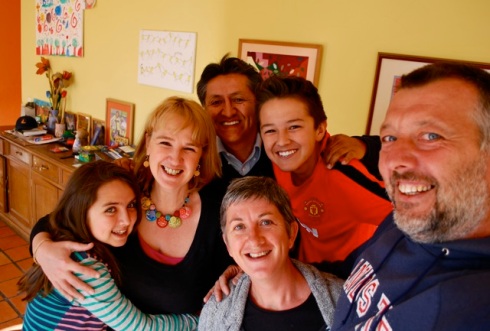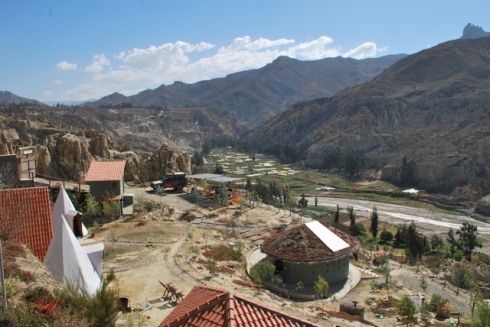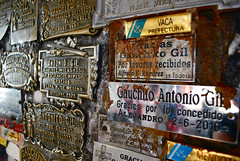Salta, Argentina
[by Paula]
Given how unbelievably sweaty, dusty and thirsty we were, it was hard to imagine how it must have been for the 17th-century Jesuit priests who had to trek here from Paraguay. I mean, I don’t think they even had ice cream shops then.
The majority of our associations with Bolivia are of the fresh air and mountain backdrops of the altiplano, so travelling through these baking hot tropical plains felt like we’d been transported to another country. Each time we had to search for a shady spot, or drive round a zillion little shops looking for ice, we said: “This just doesn’t feel like Bolivia.”
The eastern lowlands of the country may be less known by tourists, but they cover a vast area, accounting for about two-thirds of Bolivia’s land mass. We had headed south-west from Cochabamba with a plan to visit a series of former Jesuit missions, established in the late 1600s and early 1700s as settlements that were – of course – each centred around an elaborate church. The towns – in which numerous groups of indigenous people were converted to Christianity by the Jesuits before they were expelled by the Spanish king in 1767 – are still living, working communities. The central squares and churches have been lovingly restored and are a sight to behold that way exceeded our expectations.
The thing about the ‘missions circuit’ though, is that it’s not just all about wandering around looking at lovely churches and plazas. There’s a bit of an awkward 1,000km journey through the countryside to get round the major ones, and clearly that was something we couldn’t resist.
We picked a clockwise route that bypassed the city of Santa Cruz and first headed north towards the oldest of the mission towns, San Xavier. We’d got hold of a pretty detailed guide to the different missions and how to get there. On day two of driving we were finally getting close! We just had to cross a little river and we’d be a few kilometres from our first destination. There was just one thing missing from the maps and info – the lack of a bridge over the river.
After a confusing search through a dusty town for the ‘road’ to San Xavier, we were very baffled to find a rickety wooden platform jutting out and then ending suddenly on a muddy riverbed. Where’s the bridge? we pondered, squinting into the sun in search of hope.
Nope, definitely no bridge. We were expected to descend from the platform and then drive about 300m over the damp clay-ish mud and through a few streams to get to the road on the other side. Our instincts screamed ‘this will end badly!’.
A bunch of slightly drunk guys were, hilariously, charging drivers 100 Bolivianos ($14) to make the crossing. As we pondered and watched other drivers successfully making it over, they kept saying “you’ll be fine, you’ll do it!”. The thing is they, were probably right, there was a reasonably high chance we would have made it without getting trapped in the gluey mud, or without sinking into one of the streams. I just wasn’t in the mood to take the chance with our heavy van, on which we’d just spent a lot of time and money doing maintenance work, knowing how much we would kick ourselves if it went wrong.
In these situations, when lots of people are yelling in our ears with ‘helpful advice’, we have learned to stop and think carefully and ask ourselves questions such as these: Do they know what they are talking about? What will they gain/lose if we decide to go or not go? Do they give a shit about what happens to our car? If one car a day needs to get pulled out of this riverbed, how likely is it that it will be us?!
It was agony, but in the end we went with our instincts. There was a long way round to get to a different section of the route, with a bridge, that would involve several hours of extra driving. With heavy hearts we turned around, hooted and waved to the drunks and, with that, ended their afternoon of entertainment.
Over the next few hours of rutted roads that never seemed to end, we grumbled but deep down knew we’d done the right thing. Interestingly, the detour took is through three villages named Okinawa I, II and III – a corner of Bolivia that’s home to people who arrived from Okinawa as sponsored migrants in the 1950s. Tiny elderly women of Japanese descent scurried around the streets. One was so small she walked under our wing mirror without ducking. “This really doesn’t feel like Bolivia!” we repeated.
The change of route meant the day ended with us pulling into a gas station in the dark, to spend the night. The fact that they sold ice-cold beer lightened the mood considerably.
In the morning we started again with renewed vigour. We arrived in San Xavier by lunchtime, and thought ‘well, if this is what we’re getting, we can live with a little discomfort’.
Founded in 1691, it was the first of the mission settlements in the Chiquitania region. It set the scene for a series of gorgeous, pristine, plazas and church complexes we were to visit on our circuit.
But damn it was hot. It seemed like a long time since we had experienced the 50-metre-dash-to-the-shade-via-the-first-ice-cream-we-can-find race. We escaped to a hotel garden to camp for the night. A weird and, as it turned out, virtually abandoned, place – where the caretaker lied about it being open to justify charging us an exorbitant camping rate – but a haven nonetheless.
Next was Concepción, one of the best restored and conventionally beautiful of the mission towns. In a recurring theme of the week, we arrived just as everything was closing for a massive siesta. While waiting for the church and museum to reopen we killed the time by enjoying our first taste of the region’s food – a succulent roast beef, with a bizarre but strangely comforting cheesy ‘rice pudding’, yucca and plantains. More carbs anyone?
The next section to San Ignacio was quite long, but we’d read the road had recently been paved so set off to see how far we could get. That thing we read about the road being paved? That was a work of fiction. Not far out of Concepción we hit the start of a 400km stretch of hard-packed mud and gravel roads that would last all the way to our 6th and final destination. We’d expected plenty of it, but just not this much.
It slowed things down a bit, and we and the van turned a nice orange dust colour in the process, but all was well and the route was very pretty. With no prospect of arriving at any town before dark, we pulled into a tiny village and asked if we could park up for the night – of course, they said, pointing us towards the church. Two young boys were sent over later to deliver about 25 bananas to us. ‘We grow them here,’ they said, before sitting down for a chat and a glass of lemonade.
It was certainly one of the quietest and darkest nights we’d ever had. Our van shone like a beacon as none of the four houses in the village, nor the church or school, had electricity.
On the way to San Ignacio the following day we encountered a rare section of road that was being worked on. A bus coming towards us slipped and slid through the churned up mud and came to a halt at a jaunty angle. As all the passengers got off to walk through the rest of the roadworks, we thought ‘hmm, don’t really fancy driving through that’. Luckily the workmen had the same thought and sent a tractor ahead of us to pave our way.
We were glad to arrive in San Ignacio, a bigger town where we planned to base ourselves for a couple of nights. With the heat and dust we were, by this time, pretty stinky and hot and were keen on finding a shower. We had a very sweaty, fruitless search for somewhere to camp before eventually being directed to some ‘cabanas’ on the edge of town. We bumped along a farm track before arriving at a sumptuous hacienda with its own private lake, and thought ‘jackpot!’. Problem was, it was now the private home of a rich guy who seemed a little surprised at our asking to camp. Jeremy made his best disappointed face and he agreed that we could park up in the garden but could offer zero facilities. Another night of being smelly and hot then, but a partial jackpot as the location was amazing.
Next day we got a cheap hotel room to hang out and rest for a bit – we wanted to stay around for the evening because the rodeo was in town! Brilliant. It was part of a big agricultural expo event, so we ambled along and spent the evening wandering the stalls, drinking beers and cocktails, eating chunks of barbequed meat and generally wishing we were cowboys. But cowboys don’t drink cocktails, we hear you cry. Well they did at this event, which was crammed with Brazilians from over the nearby border. Every other stall was selling the Brazilian signature cocktail ‘caipirinhas’ and people seemed to be talking a hybrid S-Portuguese. “This doesn’t feel like Bolivia,” we said.
Just before the rodeo got going – three hours later than billed, you’ve got to love Latin America-time – the contestants lined up to pray and cross themselves. It was a great few hours of entertainment and people-watching, though what motivates people to get themselves violently tossed around then thrown off a bull or horse and slammed into the dust is beyond me. There must be a lot of work for osteopaths in these places.
We moved on to the two smaller missions of San Miguel and San Rafael. These places are becoming more popular with visitors but they are not exactly crawling with groups of tourists. At the first we had to search the town for the guy who had the key to the church. Several people told us ‘Carmelo’s the guy you need, he’s a few blocks that way..’ We wandered in the afternoon heat, asking for Carmelo. ‘That door up there,’ ‘No, the next house…’.
Eventually Carmelo appeared at his window, stretching, having just awoken from his siesta. He pulled on a shirt and walked back to the plaza with us, chatting away enthusiastically about how he’s been showing people round the place since he was a child, and is now in his 70s. After a fascinating little tour, we headed off to the next place on our circuit.
Again, in San Rafael there was nowhere obvious to camp. We asked at the tiny police station on the plaza where they thought might be best to park up. ‘Right here, outside the station!’ they insisted.
We wandered off to watch the Sunday night mass in the Jesuit church, and sat in the busy square cooling off before heading to bed. It’s a quaint little village, but we had one of the noisiest night’s sleep ever, with cars passing, donkeys braying, cockerels going at it, horse clopping by and a huge crowd of people flooding out of a late night meeting.
It’s not an easy trip to do by public transport. As we left early next morning we picked up two Swiss tourists who’d been left high and dry due to a fictional bus timetable. We all bumped along on the final four hours of dirt road, to the spectacular town of San Jose de Chiquitos, with its atypical baroque-style church.
Joy of joys, the town had a luxurious camping place, in the garden of a posh hotel. Just the prize we had hoped for after getting to the end of the circuit. We got things cleaned up a bit and recharged a little before the next stage of the journey.
Question was, what was the next stage going to be? There were other things we wanted to see in Bolivia, but we only had two days left on our vehicle permit before we’d either have to apply for an extension or get out of the country. It was a painful dilemma, but having had 6 wonderful months in Bolivia we decided to end it on a high and not go through the hassle of battling with the customs people in Santa Cruz.
Besides, we had an incredible itch to turn south and cross the border into Argentina. This trip is full of little and big milestones, but after all the drama we’ve had with the van, actually making it to Argentina is up there with the biggies.
We’d still have a long way to go but crossing that line would feel, to a small extent, like mission accomplished.
Days: 1,050
Miles: 22,906
Things we now know to be true: If you don’t have the ability to see into the future, go with your gut.
MORE PHOTOS IN THE GALLERY BELOW:

